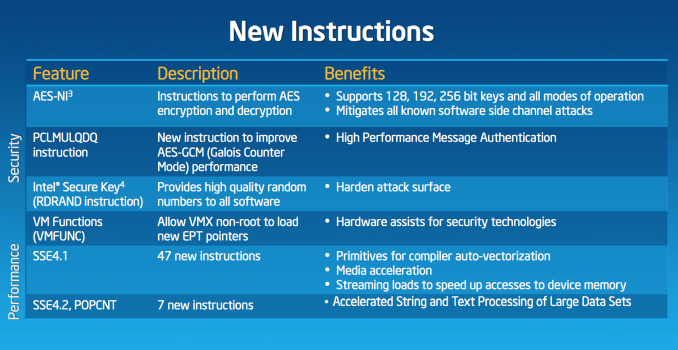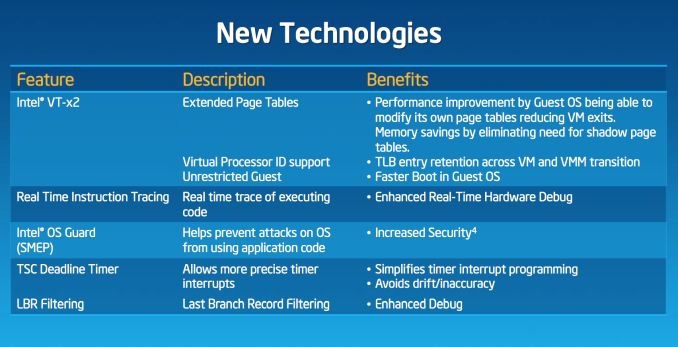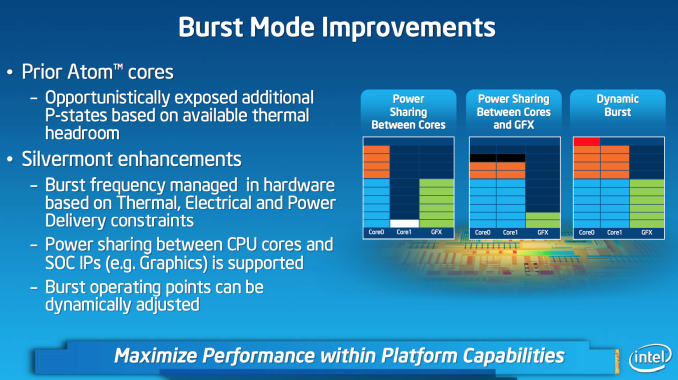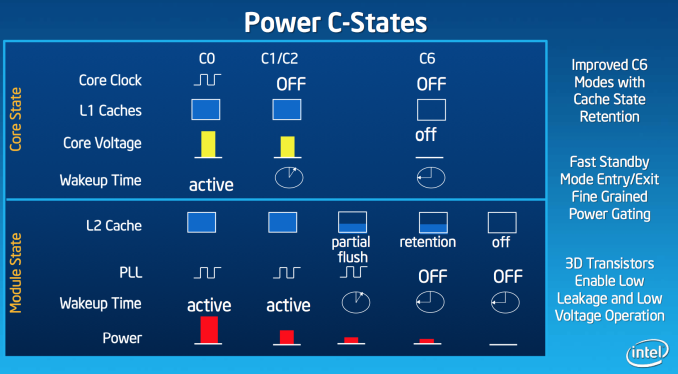Intel’s Silvermont Architecture Revealed: Getting Serious About Mobile
by Anand Lal Shimpi on May 6, 2013 1:00 PM EST- Posted in
- CPUs
- Intel
- Silvermont
- SoCs
ISA
The original Atom processor enabled support for Merom/Conroe-class x86 instructions, it lacked SSE4 support due to die/power constraints; that was at 45nm, at 22nm there’s room for improvement. Silvermont brings ISA compatibility up to Westmere levels (Intel’s 2010 Core microprocessor architecture). There’s now support for SSE4.1, SSE4.2, POPCNT and AES-NI.
Silvermont is 64-bit capable, although it is up to Intel to enable 64-bit support on various SKUs similar to what we’ve seen with Atom thus far.
IPC and Frequency
The combination of everything Intel is doing on the IPC front give it, according to Intel, roughly the same single threaded performance as ARM’s Cortex A15. We’ve already established that the Cortex A15 is quite good, but here’s where Silvermont has a chance to pull ahead. We already established that Intel’s 22nm process can give it anywhere from a 18 - 37% performance uplift at the same power consumption. IPC scaling gives Silvermont stable footing, but the ability to run at considerably higher frequencies without drawing more power is what puts it over the top.
Intel isn’t talking about frequencies at this point, but I’ve heard numbers around 2 - 2.4GHz thrown around a lot. Compared to the 1.6 - 2GHz range we currently have with Bonnell based silicon, you can see how the performance story gets serious quickly. Intel is talking about a 50% improvement in IPC at the core, combine that with a 30% improvement in frequency without any power impact and you’re now at 83% better performance potentially with no power penalty. There are other advantages at the SoC level that once factored in drive things even further.
Real Turbo Modes & Power Management
Previous Atom based mobile SoCs had a very crude version of Intel’s Turbo Boost. The CPU would expose all of its available P-states to the OS and as it became thermally limited, Intel would clamp the max P-state it would expose to the OS. Everything was OS-driven and previous designs weren’t able to capitalize on unused thermal budget elsewhere in the SoC to drive up frequency in active parts of chip. This lack of flexibility even impacted the SoC at the CPU core level. When running a single threaded app, Medfield/Clover Trail/et al couldn’t take thermal budget freed up by the idle core and use it to drive the frequency of the active core. Previous Atom implementations were basically somewhere in the pre-Nehalem era of thermal/boost management. From what I’ve seen, this is also how a lot of the present day ARM architectures work as well. At best, they vary what operating states they expose to the OS and clamp max frequency depending on thermals. To the best of my knowledge, none of the SoC vendors today actively implement modern big-core-Intel-like frequency management. Silvermont fixes this.
Silvermont, like Nehalem and the architectures that followed, gets its own power control unit that monitors thermals and handles dynamic allocation of power budget to various blocks within the SoC. If I understand this correctly, Silvermont should expose a maximum base frequency to the OS but depending on instruction mix and available TDP it can turbo up beyond that maximum frequency as long as it doesn’t exceed TDP. Like Sandy Bridge, Silvermont will even be able to exceed TDP for a short period of time if the package temperature is low enough to allow it. Finally, Silvermont’s turbo can also work across IP blocks: power budget allocated to the GPU can be transferred to the CPU cores (and vice versa).
By big-core standards (especially compared to Haswell), Silvermont’s turbo isn’t all that impressive but compared to how things are currently handled in the mobile space this should be a huge step forward.
On the power management side, getting in and out of C6 should be a bit quicker. There's also a new C6 mode with cache state retention.















174 Comments
View All Comments
MelodyRamos47 - Sunday, May 12, 2013 - link
If you think Emma`s story is super..., a month back father in-law also earned $6677 putting in from there apartment and their roomate's step-sister`s neighbour has done this for 6 months and easily made more than $6677 in their spare time from a labtop. applie the information on this link, Bow6.comCHECK IT OUTsamda - Monday, May 13, 2013 - link
I signed up here just to post this and show just how objective Anand really is."It will be insane if Silvermont reaches the 2010 MacBook Air "
Well what a load of biased ignorance.
Mr. Anand, you might want to read this and learn a bit:
http://browser.primatelabs.com/geekbench2/1946978
http://browser.primatelabs.com/geekbench2/1947269
Galaxy S4 ALREADY being there, heck even beating it easily!
Can you imagine what will a 2Ghz Octa do?
With this kind of memory? http://m.androidauthority.com/samsung-lpddr3-ram-2...
How about Snapdragon 800?
But yeah, it seems someone is being too busy sucking on Intel and living in the past!
etre - Monday, May 13, 2013 - link
Still Intel is not really trying on this market. They moved up from a 2008 design to a 2010 design on a last year process. And it took them 5 years to do that.They should have offered Haswell kind of tech, with the improvements on memory, this summer, at a killer price.
Why should I support Intel by buying an Asus Phonepad, on a promise that they will bring something sometime, instead of going for a sure bet with the new Nexus 7 and quad core Krait.
CodyCostaRica - Monday, May 20, 2013 - link
Anand,Thanks so much for this article. I would be highly interested in knowing how Intel's current and future chip road maps stack up against the competitors' current and future offerings in the mobile space (Qualcomm, NVIDIA, Samsung, Apple).
For example, how does Silvermont compare to the Apple A6X, currently used in the latest iPad?
Keep up the good work!